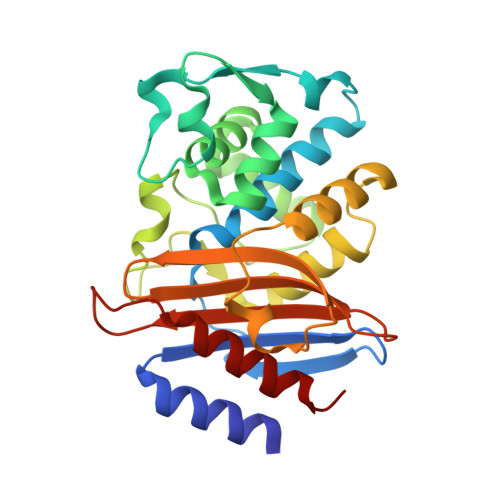Structural and Kinetic Insights Into the "Ceftazidimase" Behavior of the Extended-Spectrum Beta-Lactamase Ctx-M-96.
Ghiglione, B., Rodriguez, M.M., Herman, R., Curto, L.M., Dropa, M., Bouillenne, F., Kerff, F., Galleni, M., Charlier, P., Gutkind, G., Sauvage, E., Power, P.(2015) Biochemistry 54: 5072
- PubMed: 26228623
- DOI: https://doi.org/10.1021/acs.biochem.5b00313
- Primary Citation of Related Structures:
3ZNY - PubMed Abstract:
Diversification of the CTX-M β-lactamases led to the emergence of variants responsible for decreased susceptibility to ceftazidime, like the Asp240Gly-harboring "ceftazidimases". We solved the crystallographic structure of the Asp240Gly variant CTX-M-96 at 1.2 Å and evaluated the role of Asp240 in the activity toward oxyimino-cephalosporins through simulated models and kinetics. There seem to be subtle changes in the conformation of the active site cavity of CTX-M-96, compared to enzyme variants harboring the Asp240, and these small rearrangements could be due to localized shifts in the environment of the β3 strand. According to the crystallographic evidence, CTX-M-96 presents a "compact" active site, which in spite of its reduced cavity seems to allow the proper interaction with oxyimino-cephalosporins, as suggested by simulated models. The term "ceftazidimases" that is currently applied for the Asp240Gly-harboring CTX-M variants should be used carefully. Structural differences between CTX-M harboring the Asp240Gly mutation (and also probably others like those at Pro167) do not seem to be conclusive to determine the "ceftazidimase" behavior observed in vivo, which is in turn partially supported by the mild improvement in the catalytic efficiency toward ceftazidime by CTX-M-96 and similar enzymes, compared to "parental" Asp240-harboring variants. In addition, it is observed that alterations in OmpF expression could act synergistically with CTX-M-96 for yielding clinical resistance toward ceftazidime. We therefore propose that the observed resistance in vivo is due to the sum of synergic mechanisms, and the term "cefotaximases associated with ceftazidime resistance" could be conveniently used to describe CTX-M harboring the Asp240Gly substitution.
- ‡Centre d'Ingéniérie des Protéines, Université de Liège, B-4000 Sart Tilman, Liège, Belgium.
Organizational Affiliation:
















